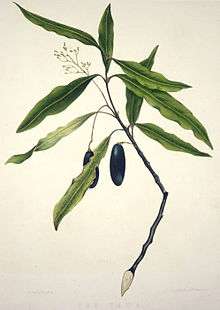Beilschmiedia tawa
| Tawa | |
|---|---|
| | |
| Scientific classification | |
| Kingdom: | Plantae |
| (unranked): | Angiosperms |
| (unranked): | Magnoliids |
| Order: | Laurales |
| Family: | Lauraceae |
| Genus: | Beilschmiedia |
| Species: | B. tawa |
| Binomial name | |
| Beilschmiedia tawa (A.Cunn.) Kirk | |
Beilschmiedia tawa, the tawa tree, is a New Zealand broadleaf tree common in the central parts of the country. Tawa is often the dominant canopy species in lowland forests in the North Island and the north east of the South Island, but will also often form the subcanopy in primary forests throughout the country in these areas, beneath podocarps such as kahikatea, matai, miro and rimu. Individual specimens may grow up to 30 metres or more in height with trunks up to 1.2 metres in diameter, and they have smooth dark bark. The word "tawa" is the Maori name for the tree.
Tawa trees produce small inconspicuous flowers followed by 2 - 3.5 cm long fruit of a dark red plum colour. With such large fruits the tawa is notable for the fact that it relies solely on the kererū (New Zealand woodpigeon) and, (where present), the North Island kōkako for dispersal of its seed. These are the only remaining birds from New Zealand's original biota large enough to eat the fruits of this tree and pass the seeds through their guts and excrete them unharmed. Tawa can also support significant epiphyte gardens in their canopies, which are one of the few habitats known to be frequented by the enigmatic, arboreal striped skink.
This tree gives its name to a northern suburb of Wellington, Tawa.
Uses
One of the few hardwood trees in the country with good timber, the wood of this tree can be used for attractive and resilient floorboarding. Although largely protected in conservation areas and by robust environmental legislation, licences are occasionally granted for the odd fallen tree to be milled for its timber.

See also
- Taraire
- Knowles, Barbara and A. E. Beveridge (1982). "Biological flora of New Zealand 9: Beilschmiedia tawa" (PDF). New Zealand Journal of Botany. 20: 37–54. doi:10.1080/0028825x.1982.10426403. Retrieved 2007-06-05.
- Kelly, Dave (1987). "Slow Recovery of Bielschmiedia tawa after severe frosts in inland Taranaki, New Zealand" (PDF). New Zealand Journal of Ecology. 10: 137–140. Retrieved 2007-06-05.
References
- H.H. Allan, 1961. Flora of New Zealand Vol. 1. Government printer.
- J. Dawson and R. Lucas, 2000. Nature guide to the New Zealand Forest. Godwit.
- W. Mary McEwen, 1978."The food of the New Zealand Pigeon (Hemiphaga novaeseelandiae novaeseelandiae)" (PDF). New Zealand Journal of Ecology. 1: 99–108. Retrieved 2007-06-29.
- A. E. Wright, 1984. "Beilschmiedia Nees (Lauraceae) in New Zealand" (PDF). New Zealand Journal of Botany. 22: 109–125. 1984. doi:10.1080/0028825x.1984.10425238. Retrieved 2010-10-07.
| Wikimedia Commons has media related to Beilschmiedia tawa. |